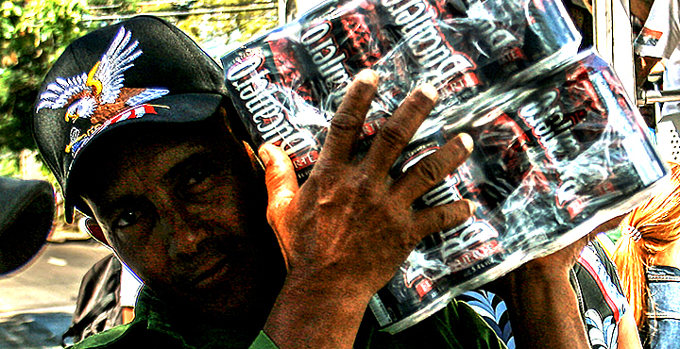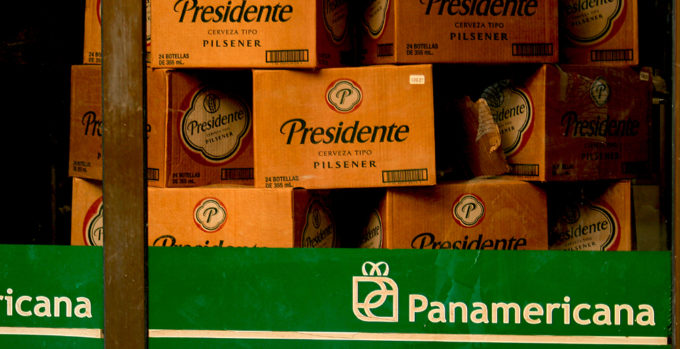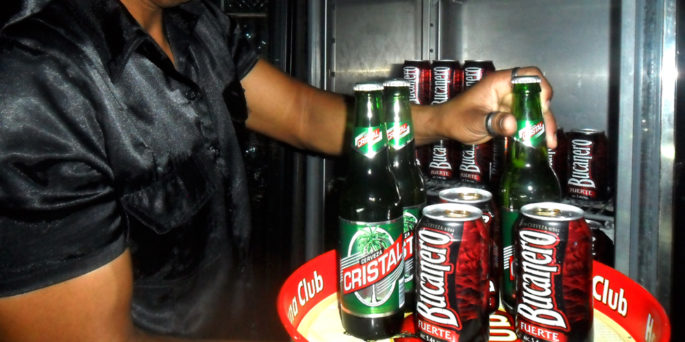
Not enough beer to go around
Beer drinkers in Cuba have been in a mild funk since the media reported on the inability of the national breweries to satisfy the growing demand of the daily trade, restaurants, dollar stores and private businesses, to which now may be added the tourist boom.
Opinions on the street go from indifference — “In any case, as long as a Cristal costs 25 pesos and I earn 400 [pesos a month], I won’t be able to afford it,” says a man in Sancti Spiritus — to disconformity, a reaction that grows in the face of shrinking supplies and the instability of the hard-currency market.
“I have just seen the owner of a paladar [private restaurant] load his car with cases and cases of beer,” says the Spirituan, Agustín Romero. “Then I go in and what do they tell me? That they’re out of beer. Sure, because I wasn’t bringing thousands of pesos to buy it wholesale but only wanted three lousy bottles.”
The scene is repeated in Havana, where our reporters have seen trucks loaded with cases of Cristal beer leave the point of sale — where they didn’t unload a single can — and head for the address that the owner of a Lada slipped to the drivers together with a hefty bribe. All that in full view of passers-by.
Some time ago, in an article that dealt with the marginal legality of private bars and discos (not restaurants, paladares or cafeterias), some of the owners interviewed by Progreso Semanal described their vicissitudes while obtaining beer for their places of business.
“It’s one of the products most widely consumed and I have to buy it — like everyone else — at a hard-currency story, bring it here, refrigerate it and spend fuel money in the search,” said one of them.
Such strategies (in addition to the illegality to which vendors find themselves “pushed,” because most owners pay the operators of the state-run points of sale to reserve them to the highest bidders) suggest networks of “solidarity” that simplify hoarding.
In Santiago de Cuba, the trucker who unloaded Cristal beer in cans told a Progreso Weekly reporter that everything was okay and that the domestic beers (Cristal and Bucanero) had not “gone missing.”
“The thing is,” the reporter had told him, “my brother’s coming from the North [the U.S.] and I want to buy beer to have at home.”
The only place where both brands were sold was the Pan.com cafeteria on Aguilera Street. At the Casa del Caribe, in Santiago de Cuba, where there’s an Artex point-of-sale we could find only Presidente brand and other imported beers costing more than 1 convertible peso [1 dollar] each.
One of the barmen said that they hadn’t had domestic brands for a long time and that it was “routine for them to be missing.”
“If you want your brother to drink beer, buy it now,” said a clerk at La Bombonera, who confided that usually someone comes around and buys the entire refrigerator, filled with Cristal bottles. The same happens with juice bottles, she added.
“Things are not like before,” she said, because the shortages have become routine.
Maybe the driver of the truck in Santiago was sincere when he said that supplies were normal. “Normalcy” is supply that does not meet the demand.

Tourism and self-employed enterprise
“The days when beer cartons gathered dust in storage rooms are over,” said Mario Durañona, a specialist at the Provincial Enterprise for Gastronomy, Lodging and Recreation, who explains that the supply has not decreased but demand has increased.
“Cristal and Bucanero beers fly out of here,” says Samy, a worker at one of the Caracol establishments in Las Tunas province. He and other workers in other provinces say that the shortage is caused by the increase in paladares and rental homes, which allegedly hoard the product because their purchasing power is greater.
Basically, there are two essential issues: the dizzying increase of tourists throughout the island (2015 saw a record figure: 3.5 million) and the inability of the domestic industry to increase production.
Two years ago, it became evident that Bucanero could not deal with the domestic demand. By mid-2014, the company admitted “production problems caused by the late arrival of the main raw material for production: beer malt from the Czech Republic.”
Technical processing, the company said, “requires a minimum cycle of 23 days, from the time the raw material is received until [the beer] is ready to be bottled for distribution and sale.”
“The Coralsa Corporation and the Joint Venture Bucanero S.A. acknowledge that they did not supply timely information to the population about the production situation and its effect on the market supply,” said at the time Yolanda Cáceres Rodríguez, president of Coralsa.
“On one hand, we are obligated to sell to most of the self-employed entrepreneurs, who still don’t have a wholesale supplier,” explains Hiyalín Menéndez León, a specialist at the Entrepreneurial Trade Group in Sancti Spiritus.
“On the other, we need to maintain our network of stores well supplied for those persons who come to buy just one or two cans.” She adds a truism that few people recognize.
“We’re trying to deal with the problem on two fronts but in the end we find ourselves between a rock and a hard place.”
Add to this the debacle caused by the shutdown of two breweries for repair and maintenance: the one in Ceballos, Ciego de Ávila, and the Manacas plant in Villa Clara, main suppliers of the bottled beer sold in Sancti Spiritus and other provinces.

According to specialist Menéndez León, it’s lucky that the Camagüey plant is trying to fill the needs for bottled beer in Sancti Spiritus, although that is only a temporary solution.
When all is said and done, the specialist says, “we can’t satisfy both the population and the self-employed workers, much less in July and August, when summer tells us ‘I’m here’.”
In July and August 2015, the government paid more than 10 million dollars in beer importation, just to maintain a minimum supply. And that was only for Havana, said an official at the Foreign Trade Ministry in an informal conversation.
Today, even in the hypothetical event that the inactive breweries were restarted and resumed production, there still wouldn’t be enough beer. So it’s not irrational to think that imports will continue to rise.
In the network of dollar stores, the situation is just as worrisome. A tour of ten stores in Sancti Spiritus, Santiago de Cuba, Las Tunas and Havana last week showed no traces of Cristal beer.
The Bucanero Tavern in Guantanamo has been dispensing Bucanero in 3-liter barrels for 7.50 CUC [convertible pesos] or 187 CUP [national pesos] because, according to one of the barmen, the supply of the domestic beers that are usually sold at the outlets of the Comercio group — Mayabe, Bucanero and Cristal — ran out almost one month ago.
Meanwhile, at the hotels in the Islazul chain in Guantánamo, beer is no problem. At the Martí Hotel, we could find the regularly sold Cristal and Bucanero for 1.15 CUC each, plus Bavaria and Heineken, both imported.
All of this suggests imbalances or maybe other illegalities in the distribution of the product, according to the means of procurement and the price (which varies in private establishments) at which it’s sold.
And in the past?
In 1958, Cuba had five breweries, which produced about 30 million liters a year for a population of about 6 million. At the time, the three brands were Hatuey, Cristal and Polar.
Little by little, the beer industry developed throughout the archipelago and brands of lesser quality appeared in various provinces: La Palma in Ciego de Ávila, Tropical in Granma, Manacas in Villa Clara and Rubia in Las Tunas.
At present, the brands most plentiful in the Cuban market are Cristal, Bucanero, Bucanero Max, Mayabe and Cacique. It is estimated that 70 percent of the beer sold in Cuba is consumed in the City of Havana and Varadero.
An analysis of public statistics on the production of domestic beer indicates that during the past decade it exceeded 2.5 million hectoliters a year. Nevertheless, the increases are modest.
| Beer production (in thousands of hectoliters) | Year |
|
2,008.5 |
1999 |
| 2,136.1 | 2000 |
| 2,197.1 | 2001 |
| 2,331.0 | 2002 |
| 2,313.3 | 2003 |
| 2,220.0 | 2004 |
| 2,459.1 | 2007 |
| 2,508.2 | 2008 |
| 2,474.4 | 2009 |
| 2,586.3 | 2010 |
| 2,589.0 | 2011 |
| 2,533.0 | 2012 |
| 2,600.5 | 2013 |
| 2,570.7 | 2014 |
(*) Contributing journalists were Gisselle Morales, István Ojeda Bello, Carlos Melián, Lilibeth Alfonso and Rachel D. Rojas.
Top photo: István Ojeda Bello.

